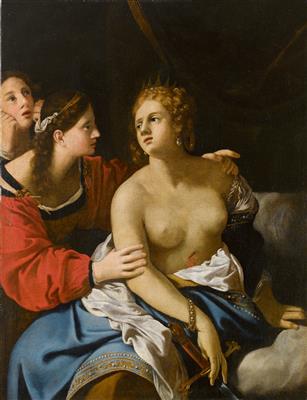Antiveduto Grammatica

(Rome ? 1571–1626)
The Suicide of Dido,
oil on canvas, 92 x 70 cm, framed
We are grateful to Gianni Papi for confirming the attribution of the present painting (written communication, February 2013).
According to Papi, elements such as the draping of the maid’s gothic style red sleeve and that of the white robe which envelopes Dido are determining factors in establishing its authorship. Both the classical and mythological subject chosen by Antiveduto, as well as the stylistic features that are visible in this work, are in keeping with the mature phase of the painter’s activity of the 1620s. At this time the Caravaggesque naturalism that had characterised his work throughout the previous decade turned towards classically inspired compositons under the influence of Bolognese artists, particularly Domenichino.
The present painting may be compared to works all dating back to the 1620s, such as Venus with Amoretti, formerly Gasparrini, Helen at the Eger Museum, Justice and Peace Kiss, private collection, and the Muses of Savoy. Three copies of the latter exist, and one in particular, Euterpe at Palazzo Chiablese in Turin, displays strong similarities, especially the perspective and the characterisation of the face (see G. Papi, Antiveduto Gramatica, Soncino, 1995).
The present painting depicts the moment of Dido’s death. According to the story recounted in Virgil’s Aeneid, the Phoenician queen committed suicide after Aeneas abandoned her. Dido was a widow and still mourned her beloved husband Sychaeus’s death, but she became besotted with Aeneas before the Trojan hero left Carthage, following Jupiter’s will, and set sail for Italy in order to fulfil his destiny as the founder of Rome. Dido sent her maids Anna and Barce away with an excuse, then committed suicide by stabbing herself with Aeneas’s sword. The scene in the painting shows precisely the moment in which the two women rush in despair towards the dying Dido, bare-chested and her mortal wound visible.
We are grateful to Gianni Papi for his assistance in the cataloguing of this piece.
15.10.2013 - 18:00
- Odhadní cena:
-
EUR 15.000,- do EUR 20.000,-
Antiveduto Grammatica
(Rome ? 1571–1626)
The Suicide of Dido,
oil on canvas, 92 x 70 cm, framed
We are grateful to Gianni Papi for confirming the attribution of the present painting (written communication, February 2013).
According to Papi, elements such as the draping of the maid’s gothic style red sleeve and that of the white robe which envelopes Dido are determining factors in establishing its authorship. Both the classical and mythological subject chosen by Antiveduto, as well as the stylistic features that are visible in this work, are in keeping with the mature phase of the painter’s activity of the 1620s. At this time the Caravaggesque naturalism that had characterised his work throughout the previous decade turned towards classically inspired compositons under the influence of Bolognese artists, particularly Domenichino.
The present painting may be compared to works all dating back to the 1620s, such as Venus with Amoretti, formerly Gasparrini, Helen at the Eger Museum, Justice and Peace Kiss, private collection, and the Muses of Savoy. Three copies of the latter exist, and one in particular, Euterpe at Palazzo Chiablese in Turin, displays strong similarities, especially the perspective and the characterisation of the face (see G. Papi, Antiveduto Gramatica, Soncino, 1995).
The present painting depicts the moment of Dido’s death. According to the story recounted in Virgil’s Aeneid, the Phoenician queen committed suicide after Aeneas abandoned her. Dido was a widow and still mourned her beloved husband Sychaeus’s death, but she became besotted with Aeneas before the Trojan hero left Carthage, following Jupiter’s will, and set sail for Italy in order to fulfil his destiny as the founder of Rome. Dido sent her maids Anna and Barce away with an excuse, then committed suicide by stabbing herself with Aeneas’s sword. The scene in the painting shows precisely the moment in which the two women rush in despair towards the dying Dido, bare-chested and her mortal wound visible.
We are grateful to Gianni Papi for his assistance in the cataloguing of this piece.
|
Horká linka kupujících
Po-Pá: 10.00 - 17.00
old.masters@dorotheum.at +43 1 515 60 403 |
| Aukce: | Obrazy starých mistr? |
| Typ aukce: | Salónní aukce |
| Datum: | 15.10.2013 - 18:00 |
| Místo konání aukce: | Wien | Palais Dorotheum |
| Prohlídka: | 05.10. - 15.10.2013 |
